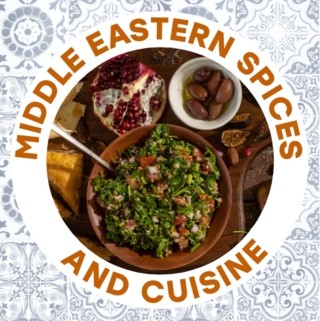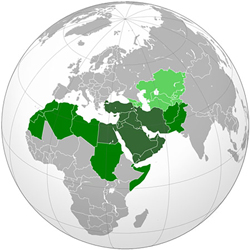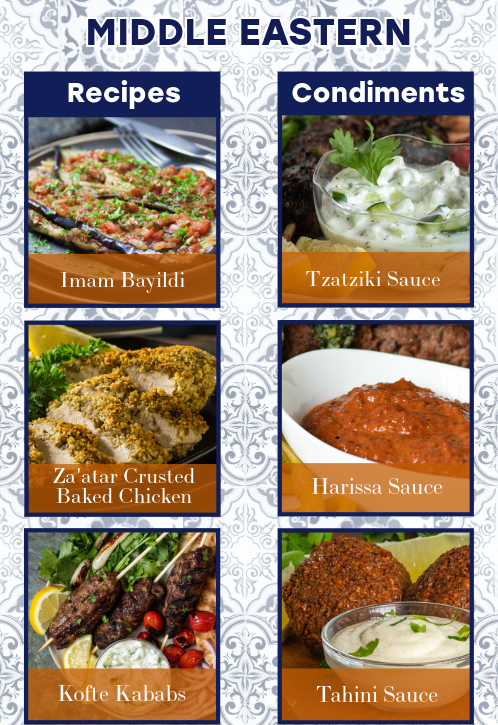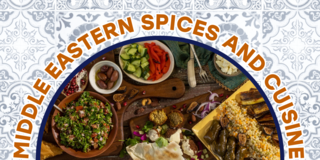Middle Eastern Spices and Cuisine

Middle Eastern Spices and Cuisine

The Middle East is more of an idea than a determinate parcel of land, one that ranges from eastern Europe to western Asia, crisscrossing the continents where Africa, Asia, and Europe converge. If you were to drop a pin into the center of the Middle East, it would land in Saudi Arabia. Countries like Egypt, Turkey, and Oman are often considered Middle Eastern countries, but you can also include “The Greater Middle East”, which extends into Asia as far east as Pakistan and Afghanistan, and as far south in Africa as Somalia. This region has considerable overlap with Mediterranean countries, and they share many food sensibilities, spices and flavors, preferences, and even origin stories.
The cultures that call this part of the world their home are abundant and diverse, and have incorporated aspects of the many broad influences that came to this global crossroads for a variety of reasons, most famously through Silk Road trading. Spices, for the most part, did not originate in the Middle East but were instead brought there by the various trading cultures.
Garlic, cardamom, and turmeric made their way to the Middle East thanks to Indian traders. Allspice, cloves, and peppercorns were carried in from the Indonesian Spice Islands. Limes are Malaysian in origin, coriander and cumin are Mediterranean, and Aleppo and other Turkish peppers came to the region thanks to the Spanish conquest of the Americas in the 15th century.
Despite the breadth of land and vast array of cultures, the cuisines in this region tends to share certain characteristics. The food tends to be aromatic and succulent, but not overly spicy. They make terrific use of grains, beans, and pulses, like lentils or chickpeas, and are not quite as meat-heavy a cuisine as can be found in other parts of the world. Lamb is often the preferred meat in traditional Middle Eastern cooking, but this can be easily swapped out for chicken or beef to accommodate the American palate.
Wheat or rice is available at every meal, whether as bread, pilaf, or matzoh and it is seasoned according to what the meal it is going to accompany tastes like. Eggplant is the most popular vegetable in the Middle East and it is seasoned with things like chile flakes and cumin. Sweet squashes like butternut, and mild squashes like zucchini, are commonly found in the Middle East, as well as vegetables like okra, leafy green chard or spinach, and root vegetables like onions, carrots, and beets.
Common Middle Eastern Spices
This list of spices is a sample of some of the most popular spices in the Middle East, from Saudi Arabia’s perennial favorites, like cardamom or cloves, to Syrian and Turkish peppers and ubiquitous cumin, found just about everywhere in this region.
- Aleppo Pepper- This is a mild, fruity pepper flake. It’s tart and a touch salty, and lends incredible nuance to savory dishes in Middle Eastern cooking.
- Anise Seed- Used frequently in breads, fruit dishes, and in cakes. It has a licorice flavor that is popular to people in the Middle East.
- Ground Nutmeg- With its warm, peppery-nutty aroma and flavor, nutmeg is wonderful in desserts and in savory cooking. In America, nutmeg is typically associated with holiday desserts, but in the Middle East it’s used year-round, in sweet and savory ways.
- Caraway Seed- This is an ingredient in the popular dessert meghli. Caraway Seed has a spicy, sweet flavor that is used in desserts and meat dishes. In the US, Caraway Seed is most recognizable as the crunchy seeds in rye bread.
- Sumac- Commonly used in a popular bread salad called fattoush, this spice is also popular for meats, rice, and vinaigrettes. Sumac is thought to be sour and a good lemon substitute in the Middle East. Sumac is one of the few spices indigenous to the US, and has been in use as long as Native Americans populated the nation.
- Cardamom- This is used in a wide variety of dishes, whether savory or sweet. You can find cardamom in Middle Eastern desserts, in coffees, and sometimes even in breads. Cardamom is also used in many beverages.
- Turmeric- Predominantly a spice used in rice, Turmeric gives food a lovely yellow hue and tastes earthy and delicious.
- Cumin- A favorite spice in the Middle East, cumin is used on everything from falafel to soups. Cumin has a broad reach and an also be found as a dominant spice in Mexican and Tex-Mex foods.
- Cinnamon- Cinnamon is often used in the Middle East to season chicken, though it can be used for a wide range of foods, from vegetables to desserts, to the sprinkle on top of coffee. In the US, cinnamon is usually considered to be solely a dessert ingredient, though its use in savory applications is creeping upward.
- Organic Pink Rose Petals- Rose petals offer a delicate aroma, a surprising hit of gentle pepper and a palate-cleansing astringency. They can be overdone, so use sparingly at first.
- Sesame Seeds- Crunchy, nutty sesame seeds are very popular in Middle Eastern cuisine. They're enjoyed as a garnish and in spice blends, and are ground into the popular paste tahini, which forms the basis for staple Middle Eastern foods like baba ghanoush and hummus.
- Urfa Biber – Dramatically colored Urfa Biber is a spicy chile flake with a tannic flavor and lingering, mid-level heat. The heat from this pepper lingers, so it will seem hotter as you continue to eat it.
Middle Eastern Seasonings
Middle Eastern seasoning blends tend to be rich and bold. They are made from a wide range of ingredients—one spice blend may include as many as twenty ingredients—and some may be spicy, but are mainly developed in the pursuit of flavor.
- Ras-el-Hanout- This blend is very versatile and when roughly translated, the name means "top shelf. There can be as few as 4 and as many as 20 ingredients in this blend.
- Baharat- Used in stews, tomato sauces, and with lentils, Baharat is an important spice blend in Middle Eastern cuisines.
- Za'atar- There are actually two versions of this blend. We have a Syrian blend which has a lighter flavor, since it's blended with lemon peel and anise. And we have a Za'atar Seasoning that is a bit more robust. They are both frequently found in hummus, chicken, fish, or vegetables.
- Shawarma Seasoning– Rich with woodsy cinnamon and cloves, and just the right nudge of cayenne, Shawarma Seasoning is great for grilling. It’s traditionally used on kebabs, but is equally at home in burgers or tossed over shrimp and sauteed.
- Harissa Spice – Harissa Spice gives the condiment harissa its characteristic heat and complex flavor. This pungent blend has a bright, pepper burn, plenty of smoky heat, and notes of mint and cinnamon.
Middle Eastern Cuisine
Middle Eastern dishes are full of flavor, whether you’re enjoying a succulent eggplant dish, soothing and creamy dips, or pungent, spice-crusted chicken. Though Middle Eastern food is renowned for its abundant flavors, it is not particularly spicy-hot, and the heat can be adjusted to reflect as much or as little heat as you would like. The array of cooking styles and food choices means there’s something for everyone in a Middle Eastern kitchen.
Try pungent grilled shawarma served in a warm pita bread, or eggplant baked until it is smooth and silky in the dish imam bayildi. Or try a classic hummus, which has become a staple in many a household and is almost always better when made at home, accented with whichever Middle Eastern spice or seasoning blend you like best.
Popular Middle Eastern Foods

